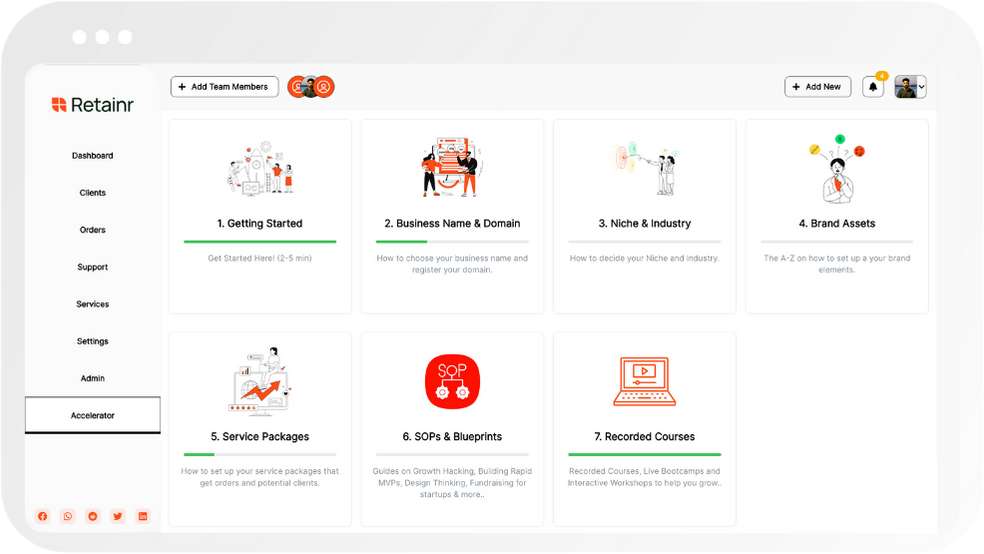
10 Tips for Creating Unique Whitelabel Solutions for Your Business
Build with Retainr
Sell your products and services, manage clients, orders, payments, automate your client onboarding and management with your own branded web application.
Get Started1. What are the key tips to consider when creating unique Whitelabel solutions for a business?
Understanding White Label Solutions
White label solutions are ready-made products or services acquired from another company to rebrand, customize, and sell as your own, and it has numerous advantages to businesses. They save time and resources in product development, allows a company to diversify product offerings, and help in building a strong branding strategy. Here are the key tips to consider when creating your own unique White label solutions:
- Identify a Reliable Supplier: A crucial step to take before you explore Whitelabel solutions is to identify a reputable supplier who can deliver a consistent quality product or service. This supplier should ideally have a track record of success in their field.
- Customize the Product: Once you have acquired the product or service, ensure that it adequately represents your brand. Alter the product design, packaging, interface to match your company's brand identity.
- Plan for Support: Consider customer service and technical support for your customers. Decide whether you will handle this in-house or if the supplier will take care of it.
Add Value to the Product
Creating unique Whitelabel solutions requires adding value to the basic product or service. This might be through additional features or a unique marketing strategy. Below are essential steps to enrich your product:
- Explore Extra Features: Consider adding more features to the existing products or services to make them unique and offer more value to your clients.
- Innovative Marketing: Implement creative marketing techniques to differentiate your product. For example, offering a loyalty program or discounts can make your product more appealing.
- Quality Assurance: Maintain a high standard for your product or service. Regular quality checks and customer feedback will help you improve your offerings.
Tailor the Solution to Meet Your Market Needs
Finally, the Whitelabel product or service should cater to the needs of your target market. Understanding your customers' needs and preferences will allow you to tailor the solution accordingly.
| Market Research: | Conduct thorough market research to understand your customers' needs and preferences. |
| Competitor Analysis: | Analyze your competitors' offerings to identify what they are doing well and where they are lacking. |
| Customer Feedback: | Invite customer feedback on your product or service, and use it to refine your offerings. |
2. How can Whitelabel solutions benefit my business?
Monetary and Time Efficiency
Whitelabel solutions are often cheaper and easier to incorporate than developing the same software in-house. High development cost, including hiring or training a team and purchasing necessary equipment is averted. Instead, a one-time fee or a reasonable subscription allows immediate use of the service. This not only saves money but also shortens the time it takes to bring a product or solution to market.
- Saves on development cost
- Averts hiring or training a team
- Reasonable subscription cost
- Quicker time to market
Focus on Core Competencies
Whitelabel solutions free up time and resources, allowing you to focus more on what your business does best. Rather than spending inordinate amounts of time on developing software, that time can be better spent on improving your actual products, expanding your market, or improving customer service.
- Time spent on product/service improvement
- More focus on business expansion
- Improved customer services
Increased Brand Visibility and Customer Loyalty
On embedding whitelabel solutions into your product or service, it offers consistent brand exposure reinforcing your brand identity. Whether it's an app or a software, as customers interact with it, your brand continues to get reinforced, boosting both visibility and loyalty. Further, customers remain within your ecosystem rather than being directed elsewhere.
| Benefits |
|---|
| Consistent brand exposure |
| Reinforced brand identity |
| Boosted customer loyalty |
| Customers remain within business ecosystem |
3. What are the primary considerations when choosing the right Whitelabel services or products?
Identify Your Business Needs
Before jumping into the world of Whitelabel services, you need to have a clear understanding of your business requirements. Specify your target market, your product offering, and the purpose of the product or service. Are you trying to expand your current offerings or do you have a new market segment you want to penetrate with this product?
- Target Market: Identify who your target customers are. Analyze their needs, expectations, and buying habits to create a product that delivers value to them.
- Product Offering: Determine what you want the product or service to offer. Will it be a stand-alone product, or will it supplement your existing range?
- Purpose: Understand what you intend to achieve with the product or service. Is it to fill a gap in the market, increase your competitive edge, or expand into a new area?
Evaluate Potential Whitelabel Partners
Once you've mapped out your business needs, you need to evaluate potential Whitelabel providers that can meet these needs. Some key criteria to consider include:
| Criteria | Description |
|---|---|
| Reputation | Research the provider's market reputation. Look at reviews, ratings, and feedback from past customers. |
| Quality of Services/Products | Assess the quality of the products and services offered by the provider. Make sure their offerings align with your quality standards. |
| Cost-effectiveness | Evaluate the cost-effectiveness of their products or services. It is essential to ensure that their offerings provide value for money. |
Consider the Technical Aspects
After zeroing in on potential Whitelabel partners based on your requirements and their reputation and offerings, focus your attention on the technical components. This will give you an insight into the functionality of the product/service and its integration into your work environment.
- Compatibility: Ensure the product or service is compatible with your existent systems.
- Scalability: The solution must be able to handle growing amounts of work in a capable manner.
- Support: The Whitelabel provider must give you ongoing technical support and training, so you can manage the product or service effectively after purchase.
4. How can I ensure the Whitelabel solution I choose is unique and fits my business needs?
Identifying a Unique and Suitable Whitelabel Solution for Your Business
Ensuring that the Whitelabel solution you choose is not only unique but also tailored to your business needs requires a strategic approach. It should begin with a comprehensive understanding of your business objectives, specific needs, and customer expectations. Following are some tips to help you achieve this:
- Outline your business needs: Understand what specific needs your business has that could be met by a Whitelabel solution. This could range from payment gateways to customer relationship management to data analytics, etc.
- Consider your customer base: Keep your customers in mind when choosing a Whitelabel solution. What features will be useful for them? What kind of user experience will they appreciate? These questions will help guide your decision.
- Thorough research: Do your homework before settling on a solution. Look at various providers, compare their offerings, read reviews and speak to other businesses who have used their solutions.
You should also consider a few other factors such as cost, scalability and the provider's reputation. An analysis of these factors can be captured in a tabular format as shown below:
| Factors | Reasons |
|---|---|
| Cost | It should be within your budget and provide a good return on investment. |
| Scalability | The solution must grow with your business and adapt to increased demands. |
| Reputation of the provider | They must be reliable and have a track record of support and regular updates. |
Eventually, the most effective Whitelabel solution will be the one that aligns with your business objectives while simplifying operations and improving user experience. It should add value to your business and help create a distinctive identity in the market. Remember, it's not about finding a unique Whitelabel solution, it's about finding the one that makes your business unique.
5. What steps should I take to properly integrate a Whitelabel solution into my existing business structure?
Planning for Integration of a Whitelabel Solution
Before integrating a Whitelabel solution into your existing business structure, there are key steps to follow. This planning phase ensures a seamless transition.
- Understand Your Business Needs: Evaluate and understand your business needs and how a Whitelabel solution can provide a solution.
- Research and select the Right Whitelabel Provider: Carefully research and select a Whitelabel provider that aligns with your business needs and goals.
- Integrating with Current Systems: Ensure the Whitelabel solution can be integrated with your current systems and processes effortlessly.
- Training: Train your team to use the new system proficiently.
- Customer Support: Choose a Whitelabel provider that offers strong customer support.
Physically Implementing the Whitelabel Solution
Physical implementation involves adding the new solution to your existing processes. It's a delicate stage that needs expert touch.
- Integration: Integrate the new Whitelabel solution with your current systems and software.
- Customization: Customize the solution to fit your brand identity and business requirements.
- Testing: Conduct rigorous testing to ensure everything works correctly and the solution fulfills your business needs as expected.
- Training (Again): Provide further training, if needed, after the solution has been fully integrated.
- Launch: Once you are confident enough, launch the solution officially in your business.
Post-Integration Follow-ups
After the Whitelabel solution has been integrated into your business, there are further steps to take to ensure long-term success.
| Steps | Details |
|---|---|
| Regularly Update | Ensure you're always using the latest version of the software to benefit from new features and enhancement. |
| Gather Feedback | Regularly gather feedback from users and customers to find any potential issues and areas for improvement. |
| Continuous Improvement | Use the feedback and your own observations to continuously improve and customize your solution. |
6. How much control do I have over a Whitelabel product in terms of customization?
Understand Your Level of Control
Customization control over a whitelabeled product largely depends on the agreement between you and the provider. Some whitelabel software providers allow high levels of customization, letting you tailor the software to your specific needs. You can adapt user-interface styles, add or remove features, and incorporate your branding elements, such as logo, color scheme, and typography. On the other hand, some providers may offer limited customization options, only allowing for basic changes like logo and name substitutions.
Varying Degrees of Customization
- Full Customization: You have comprehensive control—tweak, add or delete features, customize the interface, and incorporate your corporate branding.
- Partial Customization: Gives you moderate control—the supplier may permit some layout changes, feature alterations, and brand incorporation.
- Basic Customization: Minimal control typically reserved for smaller businesses due to lower cost—you can only change basic elements like the logo and product name.
Customization Control in a Table
| Type of Customization | Level of Control |
|---|---|
| Full Customization | Complete control with ability to change interface, features, and branding. |
| Partial Customization | Moderate control with restrictions on certain features and layout changes. |
| Basic Customization | Minimal control mostly limited to logo and product name changes. |
7. How does branding work in the context of Whitelabel solutions?
Understanding Branding in the Context of Whitelabel Solutions
Branding works in the context of white-label solutions by allowing businesses to maintain their unique identity while utilizing a rebranded product or service. In a white-label setup, the manufacturer's identity is hidden, and the buying company's branding is adopted. Below are some ways in which branding comes into play:
- Logo and Name: Your brand's logo and name are placed on the product or service, thereby associating your brand with the functionality of the white-label product.
- Color Schemes: You can apply your brand's colors to the user interface of the product. This seamless aesthetic integration can strengthen your brand identity.
- Custom User Experience: Some white-label solutions provide an option to customize the product's interfaces according to your vision. This allows you to create a unique user experience reflecting your brand's ethos.
Evaluating the Potential of Your Brand with WhiteLabel Solutions
When opting for white label solutions, assessing the potential effect it will have on your brand is essential. This can be better understood by examining the table below:
| Brand Component | Potential Effect of WhiteLabel Solutions |
|---|---|
| Brand reputation | Improves if the white-label product meets high-quality standards |
| Brand equity | Increase as customers associate your brand with a successful product |
| Brand recognition | Enhances when customers engage with an effectively rebranded product |
Maximizing Brand Potential With WhiteLabel Solutions
While branding in the context of white-label solutions comes with several possibilities, to truly maximize its potential, you must carefully select a product that aligns with your brand and offers customization. This not only ensures a cohesive appearance but also enhances your brand's value. Consider these tips:
- Product Relevance: Choose a product relevant to your brand. If the product feels out of place, it could confuse your audience.
- Customization Options: Opt for a product that offers high levels of customization.
- Quality Assurance: Lastly, ensure that the product quality aligns with the values and reputation of your brand.
8. How much time does it typically take to set up and implement a Whitelabel solution for a business?
Understanding the Timeframe for WhiteLabel Solution Implementation
The timeline for implementing Whitelabel solutions into your business depends on numerous factors such as the type of solution, the complexity of your business structure, the resources available, and many more. However, a generic timeframe can be broadly generalized which can be understood in three stages.
Preparation Stage
- Research & Planning: This can take anywhere from a couple of weeks to a couple of months. It involves understanding your needs, identifying the right Whitelabel solutions, and drafting an implementation plan.
- Vendor Selection & Licensing: Picking the right vendor and acquiring the necessary licenses based on your intended usage can take a couple of weeks up to a month.
Implementation Stage
- Integration: Typically, this is the longest part of the process. Integrating the Whitelabel solution with your existing infrastructure can take anywhere from one to three months.
- Customization: The time taken for customization depends on the extent of customization needed. Minor changes might take only a few weeks, while extensive customization can extend up to a couple of months.
Post-Implementation Stage
- Testing & Deployment: This step ensures that everything works as planned and can take several weeks. The time varies based on the size and complexity of your business.
- Employee Training: The duration of employee training largely depends on the complexity of the Whitelabel solution.
In total, setting up a Whitelabel solution typically takes anywhere from three to six months. Though some businesses have successfully done it in less time, it's always a good idea to allow for sufficient time to ensure a successful implementation.
9. What type of support can I expect from the Whitelabel service provider?
Support Expectations from Whitelabel Service Providers
White label service providers play a substantial role in ensuring the successful implementation and management of your whitelabeled solutions. Typically, their support can be divided into three key areas: technical support, marketing support, and customer service.
Technical Support
Most white label service providers offer technical support as part of their service. This often includes initial setup and ongoing maintenance of the whitelabeled solution. You should expect:
- Assistance with installation and configuration
- Software updates and bug fixes
- 24/7 monitoring and issue resolution
Marketing Support and Customer Service
Companies should also provide support in marketing the white label product and assisting with customer service. This involves:
- Branding assistance, including brand/logo integration in the software
- Marketing collateral like brochures, flyers and promotional videos
- Training and documentation for your team and customers
- Help desk support and customer service training
| Type of Support | Features |
|---|---|
| Technical Support | Installation, software updates, 24/7 monitoring |
| Marketing Support | Branding assistance, marketing materials |
| Customer Service | Training, documentation, help desk support |
10. Are there any risks or common issues to be aware of when implementing Whitelabel solutions in a business?
Risks and Issues with Whitelabel Solutions
While whitelabel solutions provide a myriad of advantages such as instant credibility, time and cost savings, and the ability to focus on core competencies, there are a number of risks and issues to consider before implementing them. These nuances might influence the overall experience and results obtained from your whitelabel solutions.
Common Risks
- Limited Control: With a whitelabel solution, you may not have complete control over the product's functionality, updates, and features. Any changes or improvements are usually dependent on the provider.
- Dependency: There is invariably a certain level of dependency on the provider. If the provider ceases to operate or decides to terminate your partnership, your business could face significant operational disruptions.
- Generic Products: There might be limited customization options, making the product less unique or tailored to your specific business needs.
Common Issues
Based on the risks mentioned above, businesses may encounter a few common issues with whitelabel products. These are summarized in the table below.
| Issue | Explanation |
|---|---|
| Quality Assurance | The provider controls product quality, making it difficult to maintain or improve standards based on your preferences. |
| Product Discontinuation | If a provider decides to stop producing or supporting a product, you may have to quickly find a replacement to avoid business disruption. |
| Customer Support | Customer service may be challenging as you are not the creator of the product. You may lack in-depth knowledge to solve more complex issues. |
Conclusion
Whitelabel solutions are essential in the current business landscape
Creating your own brand identity while leveraging an established product or service has become a compelling strategy for many businesses. With whitelabel solutions, you can offer services under your own brand, while another company takes care of development and maintenance. This strategy can save resources, increase reach and enhance brand reputation.
Here are 10 top tips for creating unique whitelabel solutions for your business:
Identify your target market and adapt your offering accordingly.
Ensure consistent branding by aligning the visual design and tone of voice between all products and communication channels.
Manage your client relationships and orders efficiently.
Choose a trusted whitelabel service provider. Quality and reliability are crucial.
Ensure there's room for customization. Whitelabel solutions should be adaptable to your business' unique needs.
Consider the pricing strategy. Pricing should be competitive, but also cover your costs and desired profit margins.
Keep track of industry changes and adjust your offering when necessary.
Opt for a simple and intuitive user interface. This could impact customer satisfaction and retention.
Optimize your product’s performance by getting regular feedback from your customers and improving accordingly.
Maintain the confidentiality of your client's data. As a provider, it's your responsibility to ensure their data is secure.
These are just a few guidelines to kickstart your whitelabel journey. A more detailed guide, specific to your industry, business size, and operational style can make your venture even more successful.
Retainr.io: The ideal whitelabel solution
A robust, reliable and smart whitelabel solution is one that can manage the complexities of your business while still being intuitive for your customers to navigate. This is where Retainr.io comes in.
With Retainr.io, not only can businesses sell their products or services under their own branded app, but they can also manage clients, orders, and payments seamlessly. It's a comprehensive solution to bring efficiency and uniformity to your process, balance your business interests, and serve your clients better.
Choose Retainr.io for an effective, easy-to-use whitelabel solution that will set you apart in your industry.
Boost Your Agency Growth
with Retainr Accelerator
Uncover secrets, strategies, and exclusive blueprints to take your agency's growth to the next level — from marketing insights to effective presentations and leveraging technology.

SOPs, Cheatsheets & Blueprints
Leverage 50+ SOPs (valued over $10K) offering practical guides, scripts, tools, hacks, templates, and cheat sheets to fast-track your startup's growth.
Connect with fellow entrepreneurs, share experiences, and get expert insights within our exclusive Facebook community.
.jpg)

Join a thriving community of growth hackers. Network, collaborate, and learn from like-minded entrepreneurs on a lifelong journey to success.

Gain expertise with recorded Courses, Live Bootcamps and interactive Workshops on topics like growth hacking, copywriting, no-code funnel building, performance marketing and more, taught by seasoned coaches & industry experts.

.jpg)

.jpeg)


